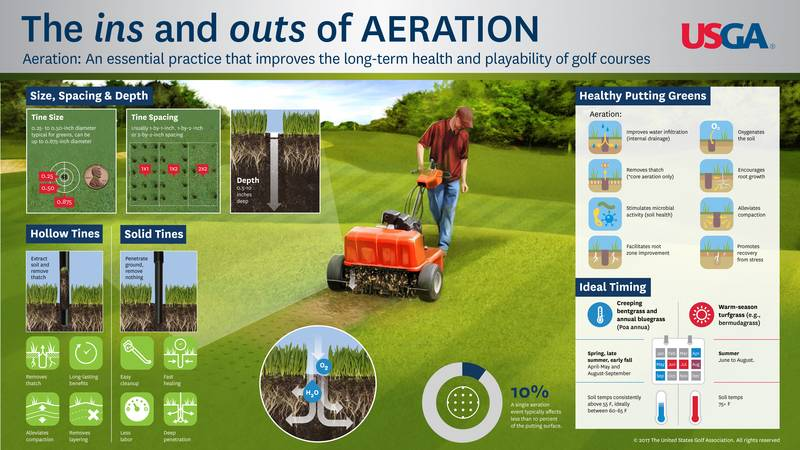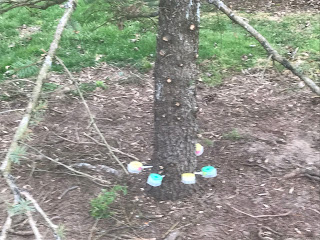 |
| The Champion overcup oak lit up at night. |
As we close the book on April and move into May, the agronomy team is looking forward to warmer temperatures. Late March and April have been colder than normal hindering many of the grow in projects. The far (north) driving range tee is opening on Sunday May 1st; however, the floor of the driving range is still in the process of germinating and will need more days of warm temperatures to fill in. One thing I have learned through phase 1 of the driving range project is the importance of seeding in August or September. Every area seeded in that time frame has come out of the winter with nice coverage and healthy turf. The areas that were seeded in mid-October into November have less germination, thin turf, and much more growing to accomplish.
Spring seeding is less effective than early fall. 1 to 3 is a good ratio when thinking about the difference in seeding. 1 week of germination in the fall equals 3 weeks to accomplish the same amount of germination in the spring. This is because the soil temperatures are very warm in early fall but take much more time to warm up after the cold winter. Since the driving range floor was seeded in early November, the turf is very thin, and the seed planted a month ago is just starting to grow. The grass should continue to fill in as we head into late spring and summer, and in June we will be sodding all the target greens with innovation zoysia (more on that on a later post).
The putting green expansion was seeded in early October and is starting to fill in but is still behind the progress of the chipping green that was planted in late September. We will continue to water and fertilize to push growth and hit the target opening dates but understand the quality of these surfaces will take some time to mature before they are able to take the daily abuse of regular play and meet current green speed benchmarks.
 |
| Floor of the driving range in late April |
 |
| Notice the left side of the floor. That was planted in November and needs time to fill in. |
 |
| New driving range tee. Seeded in September and looks great in April. |
The greens maintenance program has begun with regular topdressing, PGR applications, mowing, rolling, and verticutting taking place. The greens are scheduled for solid tine aeration on Monday, May 2nd. A contractor is used to deep-tine aerate (10" deep) the putting surfaces, and this will take all day to accomplish. We will heavily topdress after aeration to fill in holes and smooth out the surface. This is a much-needed cultural practice that reduces organic matter, helps drainage, and decreases compaction. The bottom line is to have healthy, firm, and fast greens this needs to be accomplished at least twice a year. The green speed will be slower for a week or so but will steadily increase as the greens heal. Click here to read a USGA article on aeration!
 |
| A green after verticutting. This encourages horizontal growth, decreases thatch leading to faster and firmer greens. |
 |
| Topdressing at 2 cuft/1,000 sqft. Frequent light topdressing smooths out greens and helps firmness. |
 |
| 2nd assistant Chris "Wheels" Wheeler verticutting #5 green. |
 |
| USGA illustration of the benefits of aeration |
We have received some questions about the cup changing process. The putting green cups are changed during the golf season 5 times a week. The number 1 concern with changing hole locations is to decrease wear on the greens. If cups were kept in the same location for many days the area around the cup would become compacted, stressed, and eventually die. The cups need to be rotated in order to spread foot traffic to different areas. Also, it creates different putting reads for different hole locations.
We use a 9-grid pattern for selecting pin placements, with flag colors consisting of red for the front, white for the middle, and blue in the back. If hole number 1 is in the 3 spot, hole 2 would be in the 4 spot, hole 3 would be in the 5 spot, and so on (see diagram below). There are specific holes where a hole location cannot be used (left of the middle of three green is an example). For these locations we move the cup as close as possible to the grid hole location without making it an impossible putt. Some people like aggressive cup placements and some prefer locations to be in the easiest spot possible. There have been many occasions where on the same day golfers will approach me and applaud the cup placements, and 5 minutes later other golfers will comment on the "horrendous" hole locations. Keep in mind WHCC has small greens and to properly space out foot traffic sometimes we do have to be aggressive on pin placements. We try and keep holes off of slopes, but sometimes mistakes are made especially when training new employees. We will strive to keep the cups fair and the turf healthy.
 |
9-grid cup changing pattern. Locations are moved in order daily. For example, if hole 1 is set in the 2 spot the next day it will be in the 3 spot, and the next day 4 spot, and so on.
2007 was the first year the tulip display was planted with 200 bulbs under the red oak tree. Today it has grown to around 5,000 tulips. It is always a beautiful site to see them in full bloom around Easter. Along with the tulips the grounds are home to many other spring blooming plants. WHCC has thousands of daffodils (that are deer resistant), hyacinths, and many other flowering trees and shrubs. This provides a cornucopia of spring flowers for people to enjoy. Soon the spring display will give way to the summer annuals. Here are a few pictures of the spring flowers.
|
Finally, some trees are getting treatments for diseases or other stressors. 4 blue spruce trees (3 by #7 green, 1 by the clubhouse) are getting treatments for
rhizosphaera needle cast disease. This is the disease that has killed almost all the blue spruce trees on the grounds over the last couple of years. These treatments consist of trunk injections and foliage sprays and have saved many blue spruce trees around the area. There are no guarantees but hopefully the fungicides will keep them alive. Also, the pin oak by #9 green, that was hit by lightning last year, is being treated with fertilizer applications, fungicide injections, and insecticide sprays to try and save it. This tree was recommended for removal, but there is a chance, with these procedures, it may recover and we will continue to monitor. The last tree treated is the pin oak by #17 red tee. It blocks many shots from hitting houses. It has a ganoderma infection, which is not curable but can be minimized extending the tree’s lifespan. We will be planting a tree behind the pin oak to take its place after the disease eventually runs its course.
 |
| ArborFos trunk injections for needle cast disease on a blue spruce by #7 green. |
As we enter the busy golf season the majority of our time will be devoted to daily maintenance. We are navigating the tough labor market like many other departments and industries. To say it has been tough to find employees would be an understatement. Luckily, the grounds department has many talented and loyal workers who are picking up the slack to keep the course and grounds in good shape. We will continue to navigate these rough times and hopefully the end of the school year will provide us the help we need!
Brad Piecuch
Grounds Superintendent















No comments:
Post a Comment
Note: Only a member of this blog may post a comment.